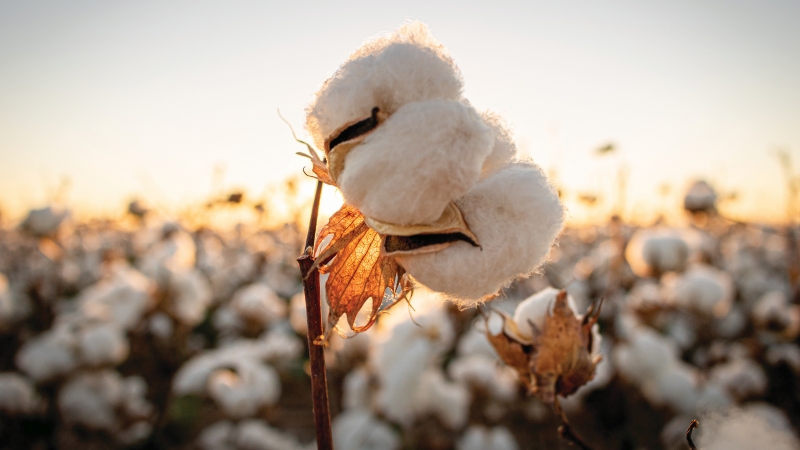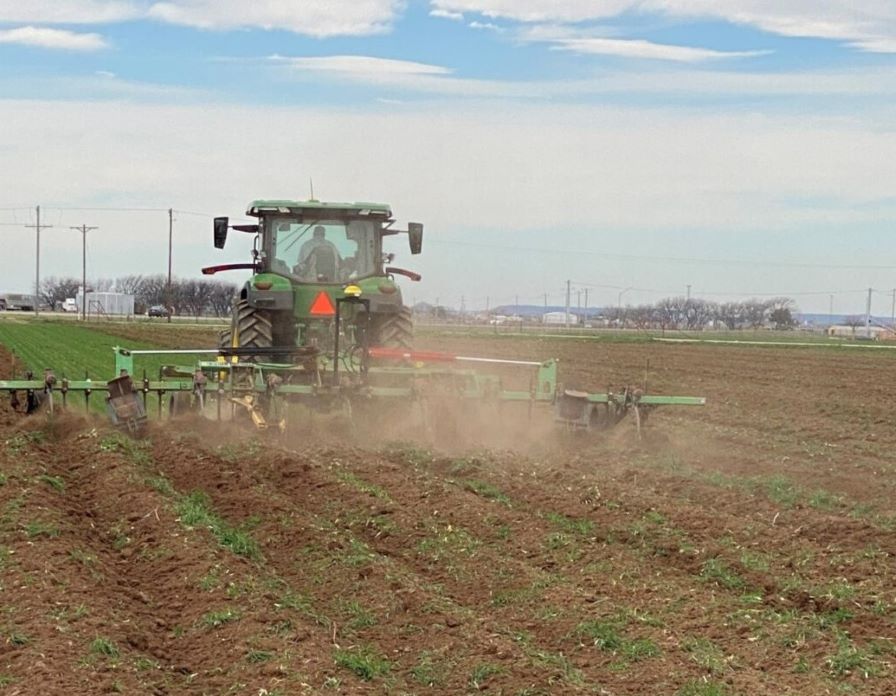Cotton Marketers of the Year – Wayne and Ed Teal
Maybe what we have here is E. F. Hutton on both sides.
“We listen to people who are world-class economists and they know what’s going on all over the world,” says Wayne Teal.
“Wayne Teal is a quiet guy who doesn’t go around talking much about what he does, but when he does, you need to listen,” says Steve Verett.
Wayne and his son Ed are the IntercontinentalExchange-New York Cotton Exchange and Cotton Grower Cotton Marketers of the year. Verett is Executive Vice President of the Plains Cotton Growers. All three call Lubbock, TX, home.
“Wayne has been a leader in the area when it comes to risk management in farming,” continues Verett. “He has been a pioneer in the use of options and futures for market risk, and has used several crop insurance options, including Group Risk Protection, to manage crop risk.”
GRP (Group Risk Plan) is a multi-peril crop insurance program.
The Teals were nominated by Bayer CropScience’s Monty Christian, and the award process is coordinated by Dr. O. A. Cleveland, a world-renowned cotton economist and professor emeritus at Mississippi State University. The award presentation took place at the Beltwide Cotton Conferences in Nashville in January.
“The Teals have the forte and savvy of marketing that just jumps out at you,” says Christian. “I see the things in them that you want to see in the Marketer of the Year.
“In talking to growers, sometimes I’m told that they are growing for the loan, because that’s where the market has been for the past several years,” Christian continues. “They may be shooting for an extra cent or two, but when you talk to Wayne Teal, he knows exactly where the market opened, he knows what the quotes are throughout the day and he knows where it closed. The Teals are just unique.”
Christian says that about a year and a half ago, Bayer commissioned a market survey through an independent company. “What I wanted to know,” he says, “was how a cotton grower markets his cotton.”
One of the most significant findings of the survey was how widespread the use of marketing pools were. “So many people go into pools because it’s safe and they don’t feel like they have the expertise to go beyond that. That’s the advantage of pools,” explains Christian. “But the Teals go in and make opportunities happen. They take control. I am just so happy to see them win this award.”
Adds Cleveland, “The Teals have been actively involved in cotton futures for 15 years or more. They have a keen expertise in making sure that they always establish a price floor. Then they take advantage of strategies that allow them to receive a higher price via the futures market.”
Down on the Farm
Wayne and Ed farm as separate entities – Wayne had 1,110 acres of cotton in 2007; Ed had 2,000 – but they still call themselves partners.
“Being a father and son who farm means we are partners,” says Wayne.
“We may be partners, but I take his advice,” says Ed.
And it’s advice that is the cornerstone of the Teal’s successful marketing strategy.
“I pay attention to people who are a lot smarter than me – O. A. Cleveland, Carl Anderson, Pat McClatchy, Mike Stevens, Joe Nicosia, Mike Stevens, Jeanne Reeves,” says Wayne.
Adds Ed, “We can study and do what we think is best, but the market could do the opposite without us knowing why until it is too late. So we listen to people who have the experience and the contacts. I am at the age where I know it’s better for me to listen to someone who has been at this longer, has the experience, and has seen it all happen.”
Wayne says the farming operation is just one part of the master plan: “Ed and I are the simplest part of the puzzle. We can figure out a way to grow some sort of crop because we have the land, and we have the experience. We can farm the cotton, but the difficult part of it is the marketing of it. We rely heavily on others, starting with Michele.”
“Michele” is Michele Crumpler of City Gin is Abernathy, TX. “She markets the cotton; her husband gins it,” says Wayne. Eugene Crumpler, Jr., is the gin manager.
“Once the cotton his been ginned, classed, and has warehouse receipting, we print a recap showing all the aspects of the grades – micronaire, color, strength, staple – everything that makes up the grade,” says Michele Crumpler. “Then I send the recap out to different buyers that we deal with, and they’ll look it over.”
Sometimes included with the recap is a price the grower would accept. “We watch the market and try to stay on top of it. We want the buyers to remember us – we don’t want to get lost in a stack of paperwork.”
If the recap price is unacceptable to the merchandiser, the price negotiations begin. “I’ve written prices on recaps that buyers have laughed at,” Crumpler says. “But my deal is, it never hurts to ask – the worst they can do is say no. That’s my mindset – sometimes they’ll laugh, but sometimes they’ll come back and ask what he’ll take.”
New York, New York
Last July, Wayne took what he says was an unforgettable trip to New York to participate in the 2007 Cotton Forum, a roundtable type conference at the New York Board of Trade.
“I was fortunate enough to have been invited by Pat McClatchy to join them,” says Wayne. “I sat and listened – I did not talk.”
Participants received an orientation at NYBOT, including an inside look at how the exchange operates. That included a mock trading session on the floor of the exchange.
The keynote speaker was Joe Nicosia, president and CEO of Allenberg Cotton Co. in Memphis.
Other panelists include Cleveland, Dr. Carl Anderson, Extension specialist emeritus, Texas A&M University; Jarral Neeper, vice-president, marketing, Calcot; Mike Stevens, Swiss Financial Services, and McClatchy, executive director, Ag Market Network.
“When you are in a room with people like that, you should do what I did – listen and take notes,” Wayne says. “It was a positive experience – something that will stay with me for the rest of my life. It was particularly humbling to sit at the roundtable with these master analysts. It was humbling just to be invited.”
Among the sponsors were Cotton Incorporated and Bayer’s Certified FiberMax Program.
The Certified FiberMax Cotton Program allows growers of FiberMax varieties to provide a guarantee to mills, merchants and other potential buyers that they have genuine FiberMax fiber for sale. “We’d like to be able to put a bar code on the bale saying it’s FiberMax, then follow it all the way through to it becoming a shirt,” says Wayne.
Dr. Jeanne Reeves, Director, Agricultural Research at Cotton Incorporated says, “We think it is important to be part of the roundtable, because in this world of constantly changing events. Learning how futures markets work, and how to add to your bottom line, will become increasingly important to cotton producers,”
It’s Not About Us
With between 80%-85% of U.S. cotton production exported, Wayne and Ed say what they do in Lubbock has virtually nothing to do with what happens at a textile mill in China. They are understating their importance because the High Plains is producing some of the highest quality upland cotton in the country.
“I know we’re growing cotton for the world market, but that’s not really what I think the most about – we have to grow the best cotton we can, no matter what,” says Ed. “We have the traits that have helped our yields and our quality. Our loan value used to be about 50 cents for what we thought was pretty good cotton. Now it’s not unheard of – especially in 2007 – to get 58-59 cents.”
“We’re not talking about what we can grow in Lubbock – we know what that is,” Wayne adds. “We’re not even talking about what we can grow in Texas or even the United States. Cotton is a worldwide crop.”
The Teals say prices are based more on what is done in Brazil, China, India and Pakistan. That’s where, the Teals say, their personal friendships with the O. A. Clevelands and Carl Andersons of the world pay huge dividends. “Ed and I have no way of knowing exactly what they are going to do in those countries, but Carl and O. A. do. They have been in these countries many, many times. All Ed and I can do is to look across the fence and see what’s happening in Lubbock, TX.
And This Year?
Most cotton-market analysts agree that we’re in for a bumpy ride as the 2008 crop year unfolds, but the market fundamentals are not discouraging for significantly higher prices for this year and next.
“As far as I can tell – and from the people I listen to – everybody is firmly convinced that we will see better prices for ‘08 and into ’09,” says Wayne. “I think some of it is based on the acreage reduction last year, and because it’s going to be trimmed again this year.”
But if the predictions of higher cotton prices comes true, will they be high enough to draw acreage away from other crops?
“We’re reducing the carryover, and I think that is helping. But I also think cotton prices are following the grains,” says Ed. “I’m optimistic for all commodities. It looks like ethanol is going to keep corn prices going for a while” – and the same could be said, for soybeans’ relationship with biodiesel – “so cotton is going to have to have some better prices to compete for acres.”
Captions (3):
Wayne Teal and his wife of 48 years, Mildred.
Monty Christian and Mildred and Wayne Teal.
Wayne and Mildred Teal with Dr. O. A. Cleveland









